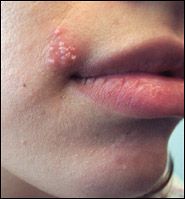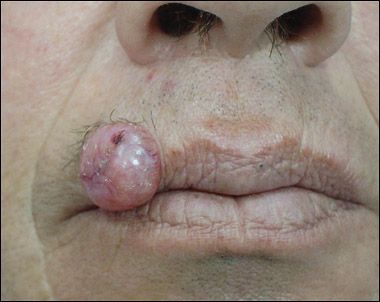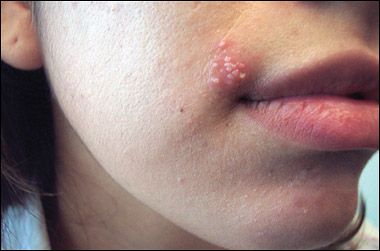Derm Match Game
Match the following characteristics with the clinical disorders pictured in the photographs of Cases 1 and 2. Then read the brief descriptions that follow on the next page to see how well you did.



Match the following characteristics with the clinical disorders pictured in the photographs of Cases 1 and 2. Then read the brief descriptions that follow on the next page to see how well you did.
Answer on Next Page
DISCUSSION
Both of the disorders presented in Cases 1 and 2 are characterized by involvement of the lip; otherwise, they are totally dissimilar. Case 1 represents a nodular basal cell carcinoma (BCC), whereas Case 2 depicts a classic case of herpes labialis. Neither entity is fungal (nor looks like any superficial fungal infection); therefore, a potassium hydroxide preparation would be unnecessary. Moreover, neither disorder is acquired from or related to household pets.

Case 1 is a previously healthy 53-year-old man whose skin lesion first developed 4 to 5 months before presentation and has been increasing in size since that time. Features that help identify the lesion in Case 1 as a BCC include the overall pearly appearance, the globoid shape, and surface telangiectasia.
Topical imiquimod 5% cream is approved for treatment of superficial BCC, which presents as flat, red, and scaly patches. However, this thick lesion would not be amenable to topical therapy and should be removed surgically. Although there are numerous operative approaches involving various flaps or grafts,1-3 surgical defects of the lip often close quite well following healing by secondary intention alone.4 In any event, care should be taken to remove the entire lesion, lest it recur. Mohs micrographic surgery might be the best option for such a large tumor in a cosmetically sensitive area; after this procedure, a recurrence rate of only 3% has been reported.5,6

Case 2 is a 22-year-old woman whose painful skin lesion developed during the 2 days before presentation, after several days of "tingling." A positive Tzanck test confirmed the clinical suspicion of herpes labialis ("cold sores"). The natural history of this disorder, caused by human herpesvirus 1, varies from infrequent to almost incessant attacks. Physical and emotional stress, sun exposure, and febrile illness may be associated with flares.
Although lesions invariably regress spontaneously, therapy may be entertained to ameliorate discomfort and cosmetic distress. Available treatments include topical and systemic antiviral agents. Application of penciclovir cream or acyclovir cream or ointment may hasten the resolution of an attack and reduce the duration of pain.7 Alternatively, oral antiviral drugs may be employed on an attack-by-attack basis: valacyclovir, 2 g every 12 hours for a total of 2 doses, or acyclovir, 400 mg 5 times daily for 5 days.8,9 Both topical and systemic therapy work best if initiated during the prodromal phase. For patients with very frequent, severe outbreaks, long-term prophylactic administration of valacyclovir (500 to 1000 mg daily) may be employed; about a 50% reduction in frequency of acute episodes may be expected.10,11
References:
REFERENCES:
1.
Bickle K, Bennett RG. Three rhombic flaps for repair of an upper lip wound.
Dermatol Surg
. 2009;35:557-561.
2.
Culliford A 4th, Zide B. Technical tips in reconstruction of the upper lip with the Abbé flap.
Plast Reconstr Surg
. 2008;122:240-243.
3.
Ethunandan M, Macpherson DW, Santhanam V. Karapandzic flap for reconstruction of lip defects.
J Oral Maxillofac Surg
. 2007;65:2512-2517.
4.
Leonard AL, Hanke CW. Second intention healing for intermediate and large postsurgical defects of the lip.
J Am Acad Dermatol
. 2007;57:832-835.
5.
Silapunt S, Peterson SR, Goldberg LH, et al. Basal cell carcinoma on the vermilion lip: a study of 18 cases.
J Am Acad Dermatol
. 2004;50:384-387.
6.
Leibovitch I, Huilgol SC, Selva D, et al. Cutaneous lip tumours treated with Mohs micrographic surgery: clinical features and surgical outcome.
Br J Dermatol
. 2005;153:1147-1152.
7.
McKeough MB, Spruance SL. Comparison of new topical treatments for herpes labialis: efficacy of penciclovir cream, acyclovir cream, and n-docosanol cream against experimental cutaneous herpes simplex virus type 1 infection.
Arch Dermatol
. 2001;137:1153-1158.
8.
Chon T, Nguyen L, Elliott TC. Clinical inquiries. What are the best treatments for herpes labialis?
J Fam Pract
. 2007;56:576-578.
9.
Cernik C, Gallina K, Brodell RT. The treatment of herpes simplex infections: an evidence-based review.
Arch Intern Med
. 2008;168:1137-1144.
10.
Gilbert SC. Suppressive therapy versus episodic therapy with oral valacyclovir for recurrent herpes labialis: efficacy and tolerability in an open-label, crossover study.
J Drugs Dermatol
. 2007;6:400-405.
11.
Baker D, Eisen D. Valacyclovir for prevention of recurrent herpes labialis: 2 double-blind, placebo-controlled studies.
Cutis
. 2003;71:239-242.